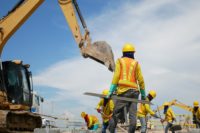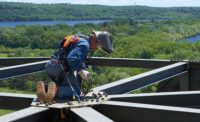| A | B | C | D | E | F | G | H | I | J | K | L | M | N | O | P |
| Q | R | S | T | U | V | W | X | Y | Z |
Abrasive blasting
Abrasive blasting can cause lung disease and damage to the nervous system when it exposes workers to respirable silica dust or particles of lead. NIOSH has a guide1 that outlines engineering controls and work practices for abrasive blasting operations and includes cleaning practices, hazard identification methods and hazard control measures.
Aerial lift
Vehicle-mounted, boom-supported aerial platforms can kill or injure workers through falls, electrocutions, and collapses or tip-overs. OSHA’s Aerial Lift QuickCard2 describes safe work practices, training, operating procedures and protective equipment.
Asbestos
OSHA has specific standards for the construction industry regarding exposure to asbestos hazards, which may occur during renovation, repairs or demolition activities.3 Employers must reduce the risks by using engineering and administrative controls and provide for the use of personal protective equipment (PPE). Airborne levels of asbestos are never to exceed legal worker exposure limits but if they do, medical monitoring of workers is required.
Bloodborne pathogens
While OSHA’s bloodborne pathogens standard does not apply to construction work, construction companies whose employees may be exposed to while performing maintenance activities are expected to train workers in how to recognize and avoid unsafe conditions and to train designated first aid providers in the hazards of bloodborne pathogens.4
Cold stress (see outdoor hazards)
Confined space
Recognizing a confined space, testing it and continually monitoring it are key to preventing injuries or fatalities, according to NIOSH, in its Preventing Occupational Fatalities in Confined Spaces publication.5 Rescue procedures are emphasized, because more than 60% of confined space deaths occur among would-be rescuers.
Cranes and derricks
OSHA has so much online material regarding its cranes and derricks rule that finding what you need can be overwhelming. A good place to start is with its Frequently Asked Questions page6. There you’ll find answers to questions like whether crane operators must be certified or qualified, and whether OSHA has a list of approved training providers.
Drugs and alcohol in the workplace
Recognizing the dangers posed by substance abuse at construction jobsites, leading construction industry associations have joined forces to provide resources for companies who want to implement an effective substance abuse policy. The Construction Coalition for a Drug- and Alcohol-Free Workplace (CCDAFW)7 provides informational tools: best practices pertaining to substance abuse policies, testing procedures, disciplinary policies and laws relating to substance abuse testing requirements and regulations.
Electrical safety
The Electrical Safety Foundation International (ESFi)8 has lots of online resources to help you practice safe work habits, including standards and best practices, industry codes and regulations — even a video that walks you through an electrical safety self-assessment.
Ergonomics
The Ohio Bureau of Workers Compensation has developed a guide entitled, “Ergonomics Best Practices for the Construction Industry”9 that recommends best practices for various situations and reports on results achieved by construction companies that implemented them.
Exposures
NIOSH has a webpage10 chock full of information intended to help safeguard the 13 million workers a year who are potentially exposed to chemicals that can be absorbed through the skin.
Falls from elevations
The Center for Construction Research and Training (CPRW) and its partners have put together a national campaign11 to prevent construction falls. Check the website for work safe brochures, training materials and other resources.
Forklift safety
The Construction Safety Council helps contractors comply with OSHA’s Powered Industrial Truck Training Standard with “Forklift Operator Training Made Simple.”12 Look for it on the Resources section of the CSC website.
Green jobs
It ain’t easy being green. The rapid move toward renewable energies and sustainable practices brings with it safety hazards both new and old. A Green Jobs workshop conducted by NIOSH covered a lot of ground; a pdf of the proceedings13 is available.
Hazard communication
Having trouble figuring out where to start when it comes to the revised hazard communication standard? OSHA has a webpage14 that breaks it all down for you.
Hearing conservation
The CPRW has a Construction Solutions database15 on its website that allows you to hone in on hearing conservation and other hazard topics via the category of work as well as the specific task being performed. Includes best work practices, administrative controls and PPE.
Heat stress (see outdoor worker hazards)
Incentives
Should your incentives program be based on accident/injury rates or on behavior? OSHA chief Dr. David Michaels urges company to use the latter16, noting that basing rewards on numbers discourages workers from reporting accidents and injuries, while incentivizing positive behaviors makes the workplace safer — the ultimate goal of incentives programs.
Ladder safety
Conduct ladder safety training with your workers using a Harvard School of Public Health-produced guide17 that will help them recognize hazards, use correct procedures and pay attention to the maximum load-carrying capacities of ladders.
Lead exposure (see abrasive blasting)
Lockout tagout (see machine guarding)
Machine guarding
OSHA’s publication, Safeguarding Equipment and Protecting Employees from Amputations18, goes from the general (i.e., safe work procedures) to machine-specific recommendations.
NORA
The National Occupational Research Agenda19 (NORA) is a partnership program that identifies the critical workplace health and safety needs and develops improved practices that address those needs.
Outdoor hazards
Extreme heat and cold aren’t the only problems that confront outdoor workers. NIOSH covers the entire spectrum of hazards and offers tips and resources tailored to each one20.
PPE
OSHA’s Fact Sheet on Personal Protective Equipment21 gives a succinct overview on the basics, like employer responsibilities and protecting specific body parts.
Qualified person, competent person: what’s the difference?
A degree or certificate, according to OSHA22. The agency defines a “qualified” person as someone who has a degree, certificate, or extensive knowledge or training that enables him to solve problems. A “competent” person, on the other hand, is capable of identifying hazards and “has authorization to take prompt corrective measures to eliminate them.”
Respiratory protection
What is a respirator? How do you make sure it fits properly? How do you monitor work areas? OSHA’s Respiratory Protection publication23 gives you the basics, in simple, easy-to-understand language.
Scaffolding
Can the scaffold hold its own weight plus four times the maximum intended load? Are its levels fully planked? Find those and other vital questions on the NIOSH Self-Inspection Checklist for scaffolds24.
Scissor lift (see aerial lifts)
Slips and trips
The Texas Office of Risk Management has an online presentation on slips, trips and falls25 that lists the most common causes (i.e., slippery surfaces, obstacles, footwear) and ways to address them (anti-skid paint, good housekeeping, shoes with slip-resistant soles).
Struck-by (see zone safety)
Silica (see abrasive blasting)
Trenching and excavation
Trench collapses cause dozens of fatalities each year. OSHA’s one-page Fact Sheet on the topic26 discusses the dangers, the types of protective systems available and general trenching and excavation rules.
Unprotected sides and edges (see falls)
Vehicle safety (see zone safety)
Walking/working surfaces (see slips, trips and falls)
Welding
Eye injuries, arc flash danger, chemical fumes, fatal falls — welding is rife with potential danger. OSHA’s web page on the topic27 lists the relevant standards and also contains information on hazards, solutions and training resources.
Young workers
Lack of experience, unfamiliarity with equipment and — let’s face it — youth makes young workers susceptible to injuries and illnesses that more seasoned workers have learned to avoid. Steer your teen workers to the construction section of the colorful web page28 that OSHA has designed just for them — and make sure you take a look at it yourself.
Zone safety
The National Work Zone Safety Information Clearinghouse29 boasts that it’s “The World’s Largest Internet Resource.” It does have an impressive number of informational offerings: crash data; training; laws and regulations; experts; safety products; standards and practices and more.




